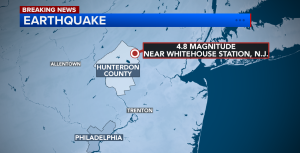The East Coast was rattled by unexpected seismic activity as a 4.8 magnitude earthquake struck New York City and New Jersey, sending shockwaves through the region. This article delves into the aftermath of this event, exploring its implications and shedding light on the response efforts.
Understanding the Magnitude
Seismic magnitude is a measure of the energy released by an earthquake. A 4.8 magnitude quake signifies a moderate event, capable of causing noticeable shaking and minor damage.
Impact on East Coast
The tremors were keenly felt in densely populated urban areas like NYC and neighboring New Jersey. Buildings swayed, and residents experienced a sense of unease as the ground shook beneath them.
Historical Context
While earthquakes are relatively rare in this part of the United States, they are not unprecedented. Historical records reveal occasional seismic activity in the region, albeit of lower magnitudes.

Seismic Activity in NYC
It’s unusual for New York City to experience significant earthquakes due to its location away from tectonic plate boundaries. However, seismic events can still occur, albeit infrequently.
Emergency Response
Authorities swiftly mobilized emergency response teams to assess the situation and ensure public safety. Rapid communication and coordination were crucial in managing the aftermath.
Building Safety Regulations
This earthquake underscores the importance of robust building codes and infrastructure resilience. Strict adherence to safety standards can mitigate the impact of such natural disasters.
Community Preparedness
Individuals and families should be prepared for unexpected emergencies. Basic supplies, evacuation plans, and communication strategies can help mitigate the impact of seismic events.
Economic Repercussions
The earthquake’s effects extended beyond physical damage, impacting businesses and disrupting economic activities. Recovery efforts will require concerted efforts from both public and private sectors.
Environmental Impact
Beyond structural damage, earthquakes can also pose risks to the environment, such as landslides and soil liquefaction. Environmental assessments are essential for mitigating long-term consequences.
Future Predictions
While it’s impossible to predict precisely when or where the next earthquake will occur, seismologists continue to monitor seismic activity and provide insights into future risks.
Mental Health Support
Natural disasters can take a toll on mental well-being. Access to mental health resources and support networks is crucial for individuals coping with the aftermath of the earthquake.

What caused the earthquake?
The earthquake was likely caused by the movement of geological faults beneath the Earth’s surface.
Was there any major damage reported?
While the earthquake caused some structural damage, it was mostly minor, with no reports of significant casualties.
Are aftershocks expected?
Aftershocks are possible following any earthquake, but their severity and frequency can vary.
How can I prepare for future earthquakes?
Preparedness measures include securing heavy furniture, creating an emergency kit, and developing a family communication plan.
Is earthquake insurance necessary in this region?
While not mandatory, earthquake insurance can provide financial protection against damages caused by seismic events.
What role do seismic monitoring systems play in earthquake preparedness?
Seismic monitoring systems help detect earthquakes early, enabling timely warnings and response efforts.
Conclusion:
Navigating through the aftermath of the 4.8 magnitude earthquake in NYC and New Jersey underscores the importance of resilience, preparedness, and community solidarity. By prioritizing safety measures, fostering public awareness, and implementing sustainable recovery strategies, we can strengthen our collective resilience and mitigate the impacts of future seismic events. As the situation continues to unfold, staying informed and prepared is key to navigating through the aftermath of the earthquake. By following safety guidelines, supporting one another, and staying updated on developments, we can collectively weather this event with resilience and solidarity.




